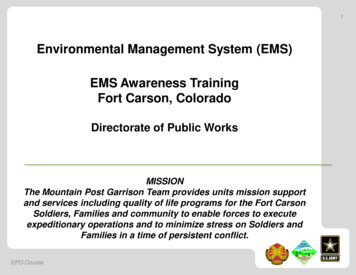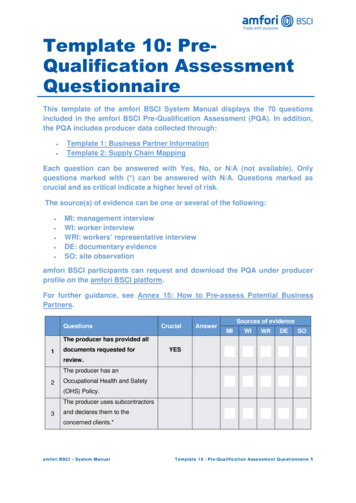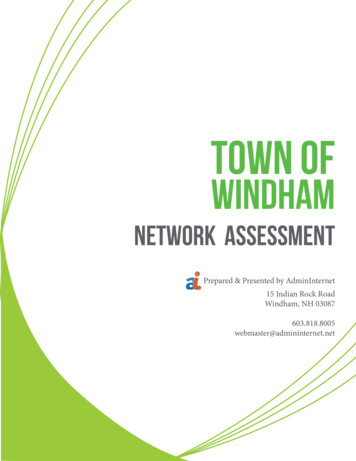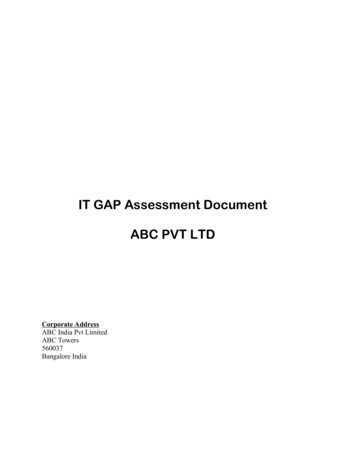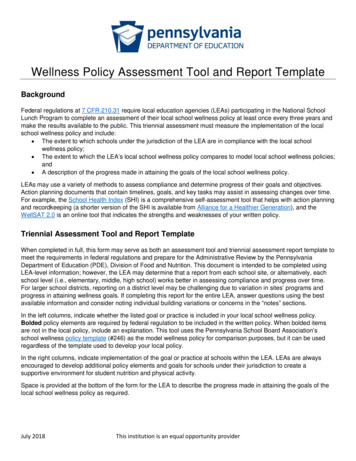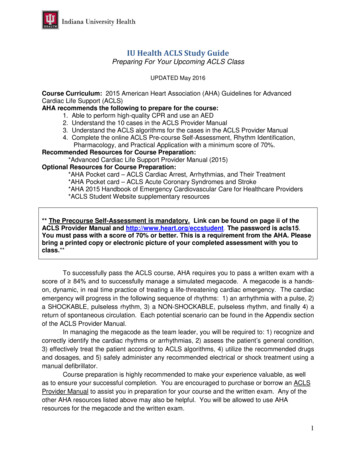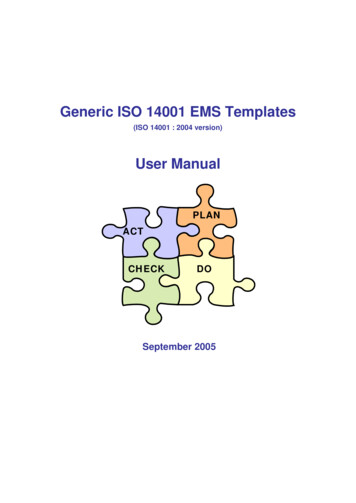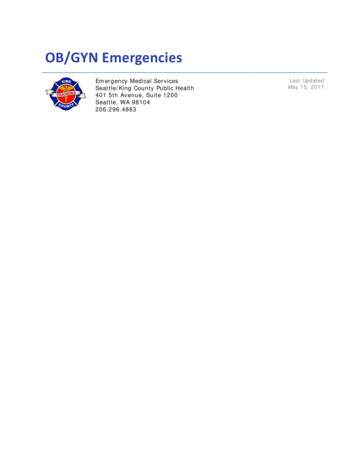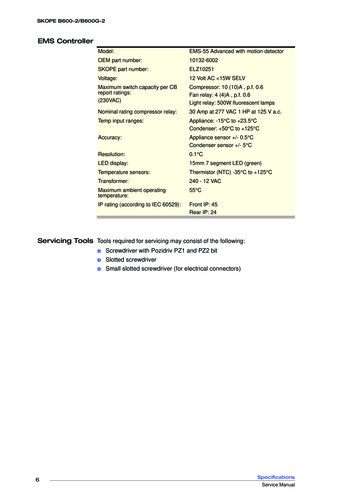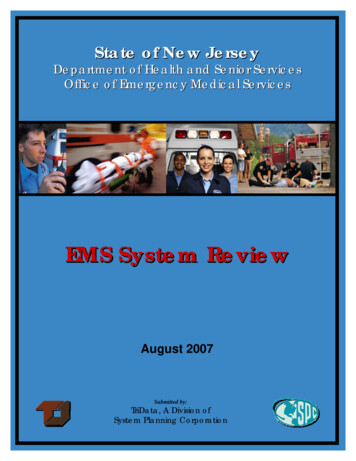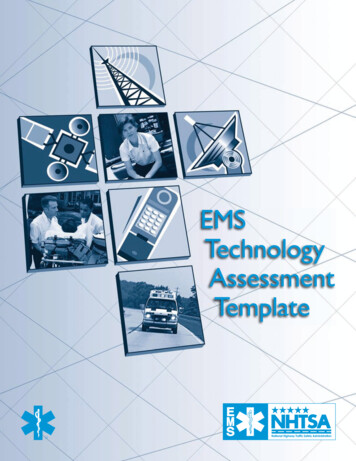
Transcription
EMSTechnologyAssessmentTemplate
EMS Technology Assessment TemplateTable of ContentsIntroduction . . . . . . . . . . . . . . . . . . . . . . . . . . . . . . . . . . . . . . . . 2Section A: Technology Assessment – Descriptive Section . . . . . . . . . . . . .4Section B: Technology Assessment – Evaluation . . . . . . . . . . . . . . . . . .8Section C: Evaluation Worksheet . . . . . . . . . . . . . . . . . . . . . . . . . . . 10Section D: References with Comments . . . . . . . . . . . . . . . . . . . . . 13 - 20Journal Articles . . . . . . . . . . . . . . . . . . . . . . . . . . . . . . . . . . 13Books . . . . . . . . . . . . . . . . . . . . . . . . . . . . . . . . . . . . . . . . 18Internet Resources . . . . . . . . . . . . . . . . . . . . . . . . . . . . . . . . 18Section E: TCC Member Roster . . . . . . . . . . . . . . . . . . . . . . . . . . . . 21Acknowledgments:NHTSA’s Office of EMS gratefully acknowledges the Intelligent Transportation System .Joint Program Office for project funding and the invaluable contributions of the Technical .Consulting Committee. Without their generous dedication of resources, time, experience .and expertise, the Technology & EMS project would not have been possible.EMS Technology Assessment Template1
InTrODuCTIOnNew medical devices and information technologiesare being proposed and marketed to Emergency Medical Services (EMS) on an ongoing basis. EMS agencies,systems, and EMS medical directors are regularly facedwith the responsibility of determining which new technologies should be adopted for patient care. In addition,they are also faced with having access to new types ofinformation about emergencies, which are availablefrom third parties, and could be provided to variouscomponents of the emergency response chain (e.g., 9-1-1,EMS, hospitals). Decisions about the value of these offerings are often made in a relative vacuum without objective data to determine the value of the new technology.Although the Food and Drug Administration (FDA) .approval of new devices is required before introduction,the FDA allows approval of devices that are “substantially equivalent” to previously approved devices basedon .the .FDA .510(k) .process 1 A medical device approvedbased on the 510(k) process is not required to havedemonstrated efficacy or proof of superiority over previously existing products. The FDA also does not addressthe important issues of interoperability and open architecture .as .they .apply .to .the .EMS .environmentTechnology assessment can be a very complicatedprocess. The “gold standard” for clinical research evaluation of new therapies is traditionally the randomizedcontrolled trial (RCT). The RCT is generally costly anddifficult to produce. It is not feasible to expect RCT levels of evidence for each incremental change or improvement of a patient care device.In addition to the RCT, there may be other types ofevaluation that could provide sufficient evidence for theEMS technology and information consumer to make aninformed decision in making investments in new technology. Even when data is available, it often relates toonly a surrogate intermediate outcome measure ratherthan the end-patient outcome. Although not ideal, evaluation using an intermediate measure is a far simplerand less expensive undertaking than true RCT outcomesresearch. The advent of an emergency medical responserecord, an electronically tallied set of events that couldbe tracked seamlessly though the various components ofthe .health .care .system .from .initiation .of .care .to .patient .outcome, would help to facilitate quality, low-cost EMSresearch .Consumers of EMS technology would benefit froma guide designed to assist in the evaluation of newtechnology. This guide would help the consumer to askinformed questions when considering new technologies.Device manufacturers could also make use of a guidewhich describes the types of evidence to be developed todemonstrate the benefit of the device being marketed toEMS. Information technology vendors could use a guidethat helps explain the needs and requirements of EMStechnology .consumersNHTSA and the National Association of EMS Physicians (NAEMSP) have jointly established the Technologyand EMS Project’s Technical Consultation Committee(TCC). This group, comprised of experienced EMSpersonnel, administrators and medical directors as wellas industry representatives, developed the EMS Technology Assessment Template contained in this document.It can be used by EMS technology developers, manufacturers, and consumers in the evaluation of new technology. The template may also help guide manufacturersand EMS technology consumers when considering thedevelopment of trials to evaluate the performance ofnew .technology .This technology assessment template is designed toevaluate information technology and EMS devices thatprovide data about patients, evaluation-oriented clinical patient information, or decision support tools. Thetemplate may also be used by consumers to determineassessment criteria for other types of EMS equipmentand treatments.This .technology .assessment .template .consists .of .two .major sections followed by a scoring worksheet. Section A is a descriptive section and presents informationabout the technology that may not have peer-reviewed1. Food and Drug Administration, Department of Health and Human Services. 510 (k) process. http://www.fda.gov/cdrh/510khome.html.2EMS Technology Assessment Template
literature support. The information presented in this section may be theoretical, presumptive, or in many cases,an educated guess.Section B asks for the objective literature and evidentiary evaluation of the technology, and describes levelsand potential types of evaluation to be performed. Mosttechnologies will have a very limited number of objective evaluations reported.Section C is for use by the TCC, medical director,or EMS system to summarize and score the information provided through the use of the template. It startswith a summary of Section A. This is followed by aweighting of the four major components of the evaluation. Those doing the assessment will need to make asubjective judgment as to the importance of each of thecomponents of the evaluation, as each medical deviceor information technology being assessed or comparedwill impact an EMS system differently. The availablesupportive literature from Section B is then rated. Thecomposite score is the product of the assigned weightsand literature evaluation scores.As a new tool, the EMS Technology EvaluationTemplate .has .limitations . .Not .all .the .items .in .Section .A .and B will be applicable to every device or informationtechnology being evaluated. Many may not apply to anyindividual device or information technology. Conversely, the items in Section A and Section B may not includeall the aspects of the device or information technologythat should be evaluated. There may be additionalitems that could be useful.The final section, a literature review, presents journal,book and Internet references used during the development of this template as well as examples of variousother technology assessment tools. Comments, summaries, and excerpts of these resources are included.This document is designed as a tool for EMS medicaldirectors, administrators, and organizations whose jobit is to make decisions about medical device and information technology adoption. The goal is for this tool toserve as a starting point in an evolution toward the useof evidence-based decisions in the deployment of newtechnologies .in .the .prehospital .arenaBy calculating a composite score, the template can beused to make a recommendation about the utility of themedical device or information technology before it is .deployed in EMS. This document offers a scoringmethod that can be used to rate a device or informationtechnology that can augment other alternative methodschosen to rate the product being evaluated.EMS Technology Assessment Template3
SECTIOn A: Descriptive SectionThis section describes components of the technology or information source being assessed. Some items ask for .assumptions and descriptions that may or may not have literature support. The descriptive section may be used to discuss potential pros and cons of the technology being evaluated.CriteriaDescription1) Type/purpose of technologyProvide a description of the technology being assessed.Explain the basic concepts behind the technology andprovide an overview of its purpose.2) Origin of technologyDescribe the origin of the technology. Is this technologynew, a modification of an existing technology, or designedas a replacement for an existing technology? If it is an .information technology, is it offering new information abouta patient, or a new analysis of information from a patient?Does it require special tools to receive the information?3) Utility – Clinical settingDescribe the clinical setting in which the technology isdesigned to be used. Is this technology designed to beused in all clinical settings or are there specific settings thatmight have greater potential benefit than others? Examplesmay include differences in population distribution such asurban, rural or frontier. Examples may also include provider level specific technologies. The technology may beapplicable to all levels of provider or may be geared .toward ALS, BLS, or air medical providers. Is there a specific niche in which the technology may provide benefit?4) System issuesProvide a description of the system changes that will berequired to take advantage of the technology. Discuss theimpact of the technology on the following: Indications for use Time required for use Utility in a mobile environment (moving ambulance orair unit) Effect on EMS time intervals (e.g., scene time, transporttime) Frequency of potential use Personnel training level required (9-1-1, FR, BLS, ALS) Training required, maintenance of skills, evaluation ofcompetence EMS Technology Assessment Template
CriteriaDescription4) System issues (continued) Infrastructure changes needed to use the technology New institutional or communications changes .necessary to use the technology IT interfaces required to be developed Ownership of the incident data; availability of it toresearchers Political or other potential obstacles to implementation Applicability to special populations, i.e., pediatric, geriatric or bariatric populations IT decision support tools required to maximize the valueof this information in concert with other data5) CostDescribe the direct and indirect costs associated with thedeployment and uses of the technology. Discuss costs .associated with required changes in the following areas: Infrastructure changes Effect on costs of various emergency response .participants and aggregate costs for the system 9-1-1 EMS system Implementation Training, initial and new personnel Recurrent costs: Training Equipment Replacement Disposable components Quality review Emergency departments Other emergency agencies Private sector (e.g., insurance) Reimbursement issuesEMS Technology Assessment Template
SECTIOn A: Descriptive Section (continued)CriteriaDescription6) Potential benefitDescribe how this technology will provide benefit to .the patient, EMS provider, or EMS system and other .affected parties. Discuss the effect of the technology .on the following: Death/Mortality Disease/Injury/Morbidity Discomfort Disability Dissatisfaction EMS, 9-1-1, hospital and other response costs, .i.e., system costs Time to definitive treatment Reduced infrastructure damage Resource impacts Focused resource utilization Productivity impact Medical cost reduction Reduced liability for response entities7) Potential harmDescribe any potential harm to the patient, EMS .provider or EMS system. Discuss the effect of the .technology on the following: Death/Mortality Disease/Injury/Morbidity Complications of treatment Discomfort Disability Dissatisfaction Medical costs Effect on EMS intervals Effect on time to definitive treatment Potential increased liability EMS Technology Assessment Template
CriteriaDescription8) InteroperabilityDescribe the information output of the technology and howit integrates into the EMS system. Is the information formatproprietary or can it be freely manipulated within the 9-1-1,hospital, and EMS systems? Discuss the following: Data format; compliance with national and internationalXML standards – e.g., NEMSIS Interface between device and personnel Interface between device and other devices, applicationsand systems not owned by the vendor; does it complywith open architecture? Is the vendor actively willing tointerface with third-party systems? Communications interoperability Data messaging capability/interoperability Rationale for the communications band used – i.e., .cellular, VHF, UHF, internet. Techniques to analyze and store the data Techniques to use the data to improve the system Does the system own the data? For information, patient data, and reporting devices,does the client have the ability to modify fields asneeded? How customizable is the product: initially and ongoing?9) Vendor qualifications and additional productissues Company or supplier qualifications Projected product life span Ease of product upgrade Customizability: initially and ongoing .(future modifications) Support available and associated costs Availability and size of technical support staff Length of contracts available Warranty Availability of replacement parts or repair On-site versus send in Cost of ownership Financial stability of the vendor Summarize MAUDE1 database reported issues1. Food and Drug Administration, Department of Health and Human Services. MAUDE database. www.fda.gov/cdh/maude.EMS Technology Assessment Template
SECTIOn B: Technology Assessment– Evaluation of the LiteratureIdeally, a technology has a scientific basis for evaluation. The studies and evaluations may address a number of different issues related to implementation and use of the technology. The level of the evidence for each item may vary significantly or may not have been evaluated. New sources of data are unlikely to have such an evaluation. Decision supporttools should, however be grounded in analysis of a significant number of events.The levels of evidence may be described in a number of different fashions. The 2005 American Heart Association(AHA) guidelines use the following descriptions for the levels of evidence used to support its guidelines:AHA Guidelines: Levels of EvidenceEvidenceDefinitionLevel 1Randomized clinical trial or meta-analyses of multipleclinical trials with substantial treatment effectsLevel 2Randomized clinical trials with smaller or less significanttreatment effectsLevel 3Prospective, controlled, nonrandomized cohort studiesLevel 4Historic, nonrandomized cohort or case-control studiesLevel 5Case series; patients compiled in serial fashion, controlgroup lackingLevel 6Animal studies or mechanical model studiesLevel 7Extrapolations from existing data collected for other purposes, theoretical analysesLevel 8Rational conjecture (common sense); common practicesaccepted before evidence-based guidelinesFor the technology being assessed, a thorough literature search and description of all of the pertinent studies, .as well as classification of the studies based on the above levels of evidence should be provided.CriteriaDescription1) Existing evaluationsDescribe all existing studies and cite all literature directlyor indirectly related to the technology and/or informationbeing assessed.2) EfficacyDescribe the performance of the technology under ideal orstudy conditions. Provide any data related to the following: Sensitivity Specificity False positive/negative rates Mechanical failure modes DurabilityIf the measures above do not directly apply to the technology, provide any information available that might be usedin assessing the technology, including: Success rate of intervention EMS Technology Assessment Template
CriteriaDescription3) EffectivenessDescribe the performance of the technology and/or .information under routine or real world conditions. .Describe any patient outcome or other literature related tothe wide spread use of the technology in and across EMSand emergency response systems. Describe any literaturerelated to the following: Wide distribution potential benefit/harm Wide distribution costs Potential lives saved Potential decreased morbidity Functionality4) Economic impactDescribe any literature which discusses a cost/benefitanalysis of the technology. Describe literature related to .the following: Cost per potential benefit Number needed to treat per unit of benefit Number needed to treat per unit of harmDescribe any other information related to any of the .following: Cost/benefit Cost/effectiveness Cost/utility5) Further evaluation recommendedDiscuss any further studies that would assist in the .evaluation of the technology. Discuss the following .in relation to this item: Studies needed to evaluate technology Cost of evaluation Number of patient evaluations necessary to .demonstrate efficacy (power evaluation) Risk of evaluation Ownership of the incident data Availability of data to researchersEMS Technology Assessment Template
SECTIOn C: Evaluation WorksheetThe evaluation worksheet is designed to be used by groups, manufacturers, EMS agencies, systems, or EMS medicaldirectors to tabulate a technology assessment. There are both subjective and objective components which contribute tothe overall score and resultant recommendation. They are as follows:1) Technology descriptiona) Provide a general description of the technology based on Sections A.1. through A.3, included in table on pagefour.b) Describe necessary system changes and costs related to implementation of the technology based on Sections A.4.and A.5, included in tables on page five.c) Describe the proposed benefit and potential harm of the technology based on Sections A.6. and A.7, included intable on page six.d) Describe the data output from the device, if applicable. Describe factors that will affect the use of the data in andout of the local EMS system based on Section A.8, included in table on page seven.10EMS Technology Assessment Template
2) Weight of components of the technology assessmentEach technology being evaluated may have different strengths/weaknesses and different levels of supportingevidence. Based on the descriptive summary in Section B found on pages eight and nine, a subjective determination will need to be made as to the relative value of the following items:ItemWeight1) Existing evaluations2) Efficacy3) Effectiveness4) Economic impactAssign a relative value on a 1–10 scale with 1 being essential, 10 being meaningless.3) Evaluation of the technologyEvaluate the weight of evidence for each of the components of the evaluation using the AHA scale of weight 1 – 8(See table entitled, “Levels of Evidence” on page eight). Give a score to each of the following items:ItemWeight1) Existing evaluations2) Efficacy3) Effectiveness4) Economic impact4) Scoring the technologyRecord the weight and evaluation for each component of the evaluation:Evaluation itemWeightXEvaluation Score 1) Existing evaluationsX 2) EfficacyX 3) EffectivenessX 4) Economic impactX ProductComposite ScoreEMS Technology Assessment Template11
SECTIOn C: Evaluation Worksheet (continued)4) Scoring the technology (continued)Describe the need for further evaluations for this technology. This may come from Section B.5, found on pagenine, or may be elucidated as part of the evaluation
other technology assessment tools. Comments, summa-ries, and excerpts of these resources are included. This document is designed as a tool for EMS medical directors, administrators, and organizations whose job it is to make decisions about medical device and infor-mation technology adoption. The goal is for this tool toFile Size: 1MB
